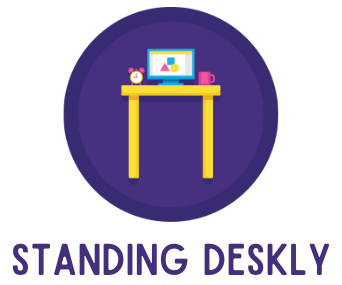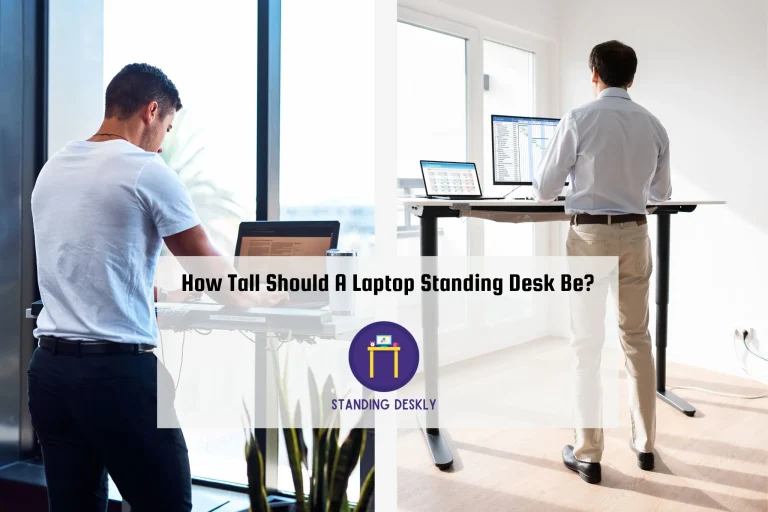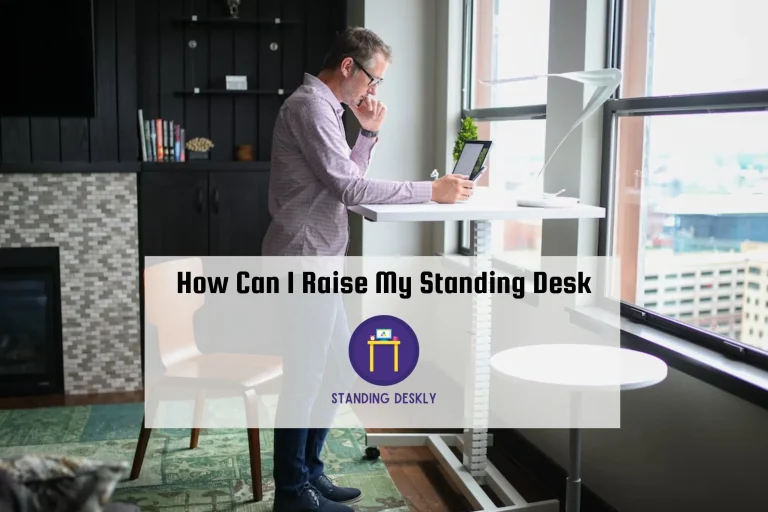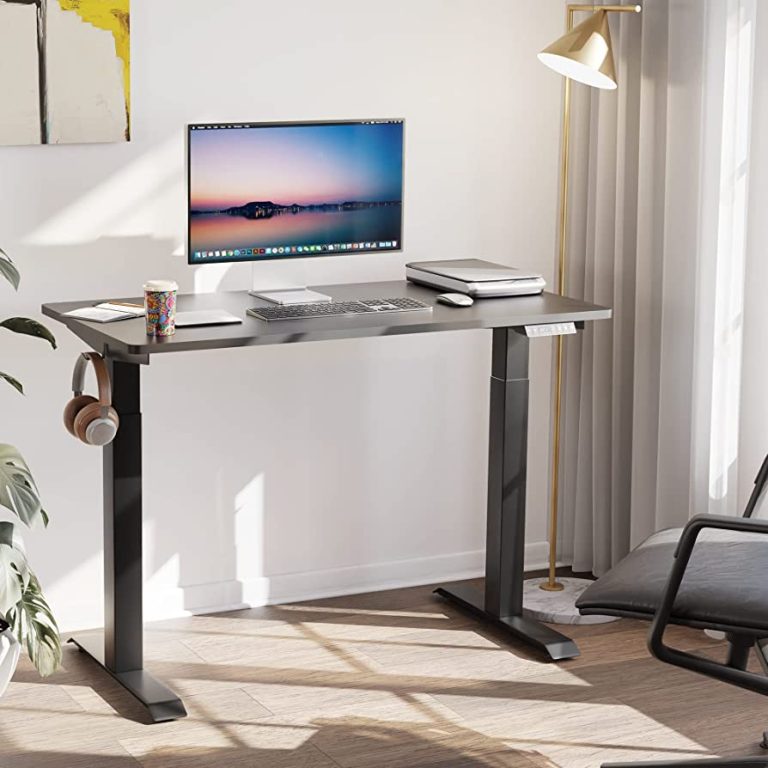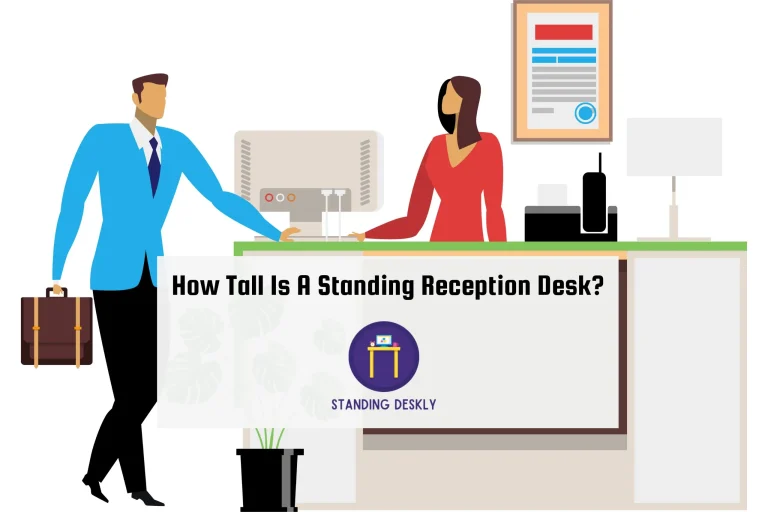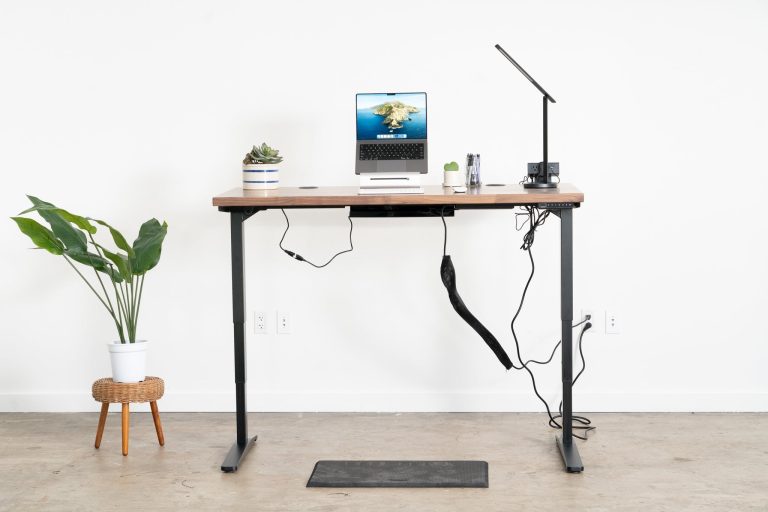Stand Up for Comfort: Shoe or Not to Shoe at a Standing Desk?
Yes, it’s recommended to wear shoes at a standing desk to provide proper arch support and avoid foot fatigue. Standing for prolonged periods can cause strain and discomfort in your feet and legs, which can be alleviated by wearing the right shoes.
When working at a standing desk for extended periods, it’s common to experience pain and discomfort, particularly in the feet, ankles, and lower back. However, wearing the right footwear can help alleviate any discomfort and prevent future problems. The right shoes will provide proper arch support and distribute weight evenly across your feet to reduce strain and improve overall comfort.
With the right shoes, you’ll be able to stand for longer periods without experiencing fatigue, allowing you to be more productive during the day. So, before you step up to your standing desk, make sure you have the right shoes to support your body and keep you feeling comfortable all day long.

Credit: www.amazon.com
Importance Of Comfort At A Standing Desk
Standing desks have become increasingly popular among those who spend long hours working at a desk. While standing has been recognized as a healthier alternative to sitting, it is crucial to consider the importance of comfort while using a standing desk.
Wearing comfortable footwear is one of the most critical factors to achieve the much-needed comfort. In this section, we will explore why wearing comfortable footwear is crucial at a standing desk.
The Impact Of Uncomfortable Standing On Health And Productivity
Standing for long periods can have negative effects on both health and productivity. If you don’t wear comfortable footwear, it can cause discomfort and strain in your legs, feet, and lower back. Let’s see some of the impacts of uncomfortable standing on health and productivity:
- Strain on muscles and joints leading to soreness and pain.
- Reduced blood flow causing swelling and fatigue.
- Decreased productivity due to discomfort and fatigue.
How Shoes Can Affect Comfort And Reduce Strain On The Body
It is essential to wear the right type of shoes to minimize discomfort and prevent long-term damage caused by standing for extended periods. Shoes provide cushioning and support, which can significantly reduce strain and discomfort. Here are some things to consider when selecting shoes to wear at a standing desk:
- Shoes with cushioned soles provide shock absorption, reducing the impact on joints.
- Shoes with arch support can reduce the strain on your feet and lower back.
- Shoes with a wide toe box allow your toes to spread and prevent cramping.
The Benefits Of Comfortable Footwear
Wearing comfortable shoes can improve posture, balance, and overall comfort, making it easier to stand for longer durations. Comfortable shoes also offer the following benefits:
- Improved blood circulation, reducing swelling and fatigue.
- Reduced risk of foot related problems such as plantar fasciitis and bunions.
- Increased productivity as a result of improved comfort and reduced pain.
Wearing comfortable shoes is vital when using a standing desk. It can help to prevent discomfort, pain, and long-term damage to the body. Invest in shoes with cushioning, arch support, and a wide toe box to reduce strain and improve posture and balance.
Remember, when it comes to a standing desk, comfort should always come first.
The Pros And Cons Of Wearing Shoes At A Standing Desk
Standing desks have become increasingly popular because of their proven benefits. However, one of the most common questions people often ask is whether they should wear shoes at a standing desk. To answer that question, we will explore the pros and cons of wearing shoes when using a standing desk.
The Benefits Of Wearing Shoes At A Standing Desk:
- Comfortability: Wearing shoes provides cushioning and support for the feet, which can help prevent foot strain and fatigue. With the proper fitting shoes, standing for long periods becomes less strenuous, allowing you to focus better on your work.
- Improved posture: Shoes provide support and help maintain proper alignment of the spine. This alignment helps to reduce back pain and pressure on the vertebrae and discs, which can occur while standing for an extended period.
- Safety: A spill, sharp object, or a heavy object falling on your feet can result in a serious injury if you’re not wearing shoes. Shoes provide a layer of protection to prevent accidents in the workplace.
The Drawbacks Of Wearing Shoes At A Standing Desk:
- Reduced circulation: Wearing shoes that are too tight or have a narrow toe box can restrict blood flow in the feet, which can lead to numbness, tingling, or swelling.
- Potential for foot deformities: Wearing shoes that are too tight can cause a variety of foot conditions such as hammertoes, bunions, and corns. These conditions can cause pain and discomfort, and in severe cases might require surgery.
- Increased sweating: Wearing shoes can cause your feet to become too warm, which could lead to excessive sweating. Sufficient air circulation helps prevent bacterial and fungal growth and promotes healthy hygiene practices.
While there are benefits and drawbacks to wearing shoes at a standing desk, the decision ultimately depends on personal preference, comfort, and the work environment. Before making a decision, consider how your feet feel without shoes and try different types of shoes to determine which provides the best support and comfort while you work.
Alternatives To Shoes At A Standing Desk
Barefoot Standing
Standing barefoot is one alternative to wearing shoes at a standing desk. Here are some key points to keep in mind:
- Standing barefoot provides natural support for the feet and helps strengthen the arches.
- It promotes good posture and encourages you to distribute your weight evenly.
- According to research, standing barefoot improves blood circulation, helps reduce inflammation, and lowers your risk of developing foot problems like plantar fasciitis.
- However, standing barefoot for an extended period can lead to fatigue, soreness, and discomfort.
Socks Or Shoe Inserts
Another option to consider is wearing socks or using shoe inserts when standing at your desk. Here are some things to keep in mind with this alternative:
- Socks provide some cushioning and can help reduce friction caused by standing on a hard surface.
- Shoe inserts are designed to support your feet and promote proper alignment to prevent foot, knee, and back pain.
- If you wear shoes with removable insoles, you can easily swap them out with shoe inserts designed for standing all day.
- It’s a good idea to choose materials that wick moisture away from your skin to prevent sweaty feet and potential fungal infections.
Anti-Fatigue Mats
Using an anti-fatigue mat is another alternative to wearing shoes at a standing desk. Here are some key points to keep in mind:
- Anti-fatigue mats are specially designed to reduce the impact of standing on hard surfaces, providing cushioning and support for your feet, legs, and back.
- They help improve circulation and reduce fatigue, soreness, and discomfort.
- You can find a wide variety of anti-fatigue mats in different sizes, shapes, and materials to suit your needs and preferences.
- Some mats even come with massage features and acupressure points that help improve circulation and relieve tension in your feet.
Standing at a desk for extended periods is not comfortable, but there are alternatives to wearing shoes that can help. By choosing the right option for you, you can help reduce fatigue, promote good posture, and minimize your risk of developing foot and joint problems.
Choosing The Right Shoes For A Standing Desk
Standing desks are increasingly becoming popular, thanks to their several health benefits. However, to benefit from them, you need to choose the right shoes. Shoes play a crucial role in determining the level of comfort you experience throughout the day when standing at your desk.
Here are some factors you need to consider when selecting shoes for standing and some of the recommended brands and models.
Factors To Consider When Selecting Shoes
Choosing the wrong shoes for a standing desk can lead to discomfort, pain, and even injuries. Therefore, it’s essential to consider the following factors:
- Comfort: When selecting shoes, ensure they are comfortable, and fit properly. Uncomfortable shoes can lead to foot and back pain, which can make standing for long hours unbearable.
- Cushioning: Look for shoes that provide good cushioning or shock absorption. Such shoes reduce the pressure on your feet and keep your body in proper alignment.
- Arch support: Proper arch support is crucial when selecting shoes for standing. It distributes your weight evenly, reduces pressure, and helps prevent conditions such as plantar fasciitis.
- Material: Go for shoes that are made of breathable materials to ensure proper air circulation and prevent sweating.
- Sole thickness: Shoes with thick soles provide more cushioning than those with thin soles, making them more comfortable for standing.
Brands And Models Recommended For Standing
Several brands and models are suitable for standing at your desk. Some of the most recommended include:
- New balance 626v3: This shoe’s slip-resistant sole provides a good grip, and the cushioned insole provides adequate comfort.
- Dansko professional: These clogs have a thick sole that provides ample cushioning and arch support, making them ideal for standing for long hours.
- Brooks ghost 13: These sneakers provide excellent cushioning, arch support, and fit, making them perfect for standing.
- Skechers work sure track: Made with shock-absorbing materials and slip-resistant soles, these shoes are a great option for those looking for comfort and safety.
- Birkenstock boston: These clogs are known for their excellent arch support, thick sole, and comfort, making them ideal for standing for prolonged periods.
Selecting the right shoes for a standing desk is essential for your comfort, productivity, and overall health. Remember to consider factors such as comfort, cushioning, arch support, material, and sole thickness, and choose from recommended brands and models for the best results.
How To Take Care Of Your Feet While Standing
Are you one of those people who spend long hours standing at work? Standing desks have become increasingly popular in the workplace, with people enjoying the ergonomic benefits that come with them. However, standing for extended periods can negatively affect your feet.
Wearing the right shoes for a standing desk is crucial and there are other ways to take care of your feet. Here’s how to take care of your feet while standing.
Tips For Reducing Foot Pain And Strain
Standing desks provide many benefits, but the downside is the strain it puts on your feet. Here are tips to reduce foot pain and strain:
- Wear the right shoes: The type of shoes you wear can have a significant impact on your feet. Choose shoes that provide ample support, cushioning, and stability. Avoid high-heels, flip-flops and shoes with flat soles.
- Stretch your feet: Include stretches that target your feet in your daily routine. Toe curls, rolling a ball with your foot, and calf stretches are great ways to ease foot pain.
- Use a footrest: A footrest will reduce the pressure on your feet and improve your posture while standing. It will also improve blood circulation in your legs.
- Use a shock-absorbing mat: A shock-absorbing mat reduces the pressure on your feet and provides a cushioned surface for your feet.
The Importance Of Rest Breaks
Standing for too long can put excessive pressure and strain on your feet. Rest breaks are essential to minimize the effects of prolonged standing. Here’s why rest breaks are important:
- Reduces discomfort: Taking short breaks to sit or walk around can significantly reduce foot pain and discomfort.
- Improve blood circulation: Rest breaks allow increased blood flow to your legs and feet, reducing the risk of swelling or varicose veins.
- Improves overall productivity: Rest breaks give your brain a chance to rest, improving your overall energy level and productivity. Aim for a 5-10 minute rest after every hour of standing.
By incorporating these tips into your routine, you can reduce foot pain and strain when standing. Remember, taking care of your feet is essential, especially when you are standing for long hours.
Maintaining Good Posture At A Standing Desk
Working at a standing desk comes with several benefits, such as reduced risk of obesity, lower blood sugar levels, and decreased back pain, but maintaining good posture is key to maximizing these benefits. Good posture refers to the alignment of your body from head to toe, and it affects your comfort and overall health.
The Impact Of Posture On Comfort And Health
Posture has a significant impact on your comfort and health when working at a standing desk. Poor posture can lead to physical and mental discomfort, muscular imbalances, and even long-term health problems. These effects include:
- Neck and back pain
- Tension headaches
- Reduced concentration and energy levels
- Digestive issues
- Cardiovascular problems
- Muscular imbalances
- Fatigue
How To Achieve Good Posture While Standing
Achieving good posture can be easy if you follow these simple guidelines:
- Keep your feet flat on the floor, shoulder-width apart, and distribute your weight evenly.
- Stand tall with your shoulders relaxed, your spine straight, and your chin parallel to the ground.
- Keep your elbows resting at a 90-degree angle close to your body and your wrists straight.
- Adjust your screen to eye level to avoid straining your neck.
Exercises For Improving Posture And Reducing Fatigue
Performing regular exercises can help reduce fatigue and improve your posture. Here are some of the exercises you can do:
- Shoulder blade squeezes: Squeeze your shoulder blades together and hold for 5 seconds, then release. Repeat this exercise for 10-15 times.
- Chest stretch: Extend your arms out to your side and squeeze your shoulder blades together. Hold for 15-30 seconds, then release. Repeat this exercise 2-3 times.
- High knee march: Raise your knees up to your hip level while standing in place. March for 1-2 minutes to improve blood circulation and reduce leg fatigue.
Maintaining good posture is essential when using a standing desk to avoid discomfort and long-term injuries. Always make sure that you are correctly positioned and perform exercises regularly to reduce fatigue. Remember to take breaks and stretch frequently to ease muscle tension and improve blood flow.
Frequently Asked Questions Of Should I Wear Shoes At Standing Desk?
Why Is It Essential To Wear Shoes While Standing At A Desk?
Wearing shoes provides arch support, reduces foot fatigue, and prevents injury from falling objects.
What Type Of Shoes Should I Wear With A Standing Desk?
Wear comfortable, well-fitted shoes with arch support and low heels, preferably sneakers or clogs.
Can I Wear High Heels To A Standing Desk?
Wearing high heels can cause pain, discomfort and even injuries, so avoid wearing them at a standing desk.
Are There Any Risks To Standing On A Hard Floor Without Shoes?
Standing on a hard floor without shoes can lead to foot, leg, and lower back pain, and poor posture.
How Long Can I Stand At A Desk Without Shoes?
It is not advisable to stand for more than 30 minutes without shoes. Take frequent breaks and stretch your legs to prevent fatigue and injuries.
Conclusion
Whether to wear shoes at a standing desk is a personal choice that depends on several factors such as personal preferences, foot conditions, and workplace dress codes. Wearing supportive shoes can help reduce the risk of foot and joint problems while standing for long durations.
However, lightweight and breathable shoes may also be appropriate depending on the nature of work. Ultimately, it’s about finding the right balance between comfort, safety, and style. Aside from shoes, taking regular breaks, shifting your weight, and performing stretching exercises can also help reduce the negative impacts of prolonged standing.
Whatever your decision may be, it’s important to prioritize your health and wellbeing while working at a standing desk to stay productive and pain-free. By following these tips, you can ensure that your workday at the standing desk is a success.

I’m the author and developer of Standingdeskly, the go-to site for standing desk enthusiasts. I provide comprehensive reviews of standing desks along with office setup tips. Combining years of research and personal experience, our goal is to make it easy for you to find the perfect standing desk tailored to your needs.
